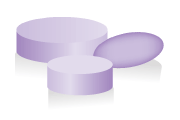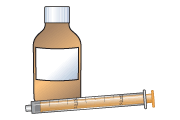Labetalol hydrochloride for high blood pressure
This leaflet is for parents and carers about how to use this medicine in children. Our information may differ from that provided by the manufacturers, because their information usually relates to adults. Read this leaflet carefully. Keep it somewhere safe so that you can read it again.
Name of medicine
Labetalol hydrochloride; also referred to as labetalol
Brand name: Trandate
Why is it important for my child to take Labetalol?
High blood pressure can lead to damage to internal organs. Labetalol is in a group of medicines called beta blockers, which help to lower blood pressure. It opens up blood vessels and slows the heart down so that it pumps less forcefully.
What is Labetalol available as?
- Tablets: 50 mg, 100 mg, 200 mg and 400 mg
- Liquid medicine can be ordered specially from your pharmacist
When should I give Labetalol
Labetalol is usually given three or four times each day. Your doctor will tell you how often to give it.
- Three times each day: this should be once in the morning, once in the early afternoon, and once in the evening. Ideally, these times are at least 6 hours apart, for example 8 am, 2 pm and 8 pm.
- Four times each day: this should be first thing in the morning, at about midday, late in the afternoon and at bedtime. Ideally, these times should be at least 4 hours apart, for example 8 am, midday, 4 pm and 8 pm.
How much should I give?
Your doctor will work out the amount of Labetalol (the dose) that is right for your child. The dose will be shown on the medicine label.
Your doctor will start your child on a low dose of Labetalol. They will check your child’s blood pressure regularly and may increase the dose if your child’s blood pressure is still too high.
It is important that you follow your doctor’s instructions about how much to give.
How should I give Labetalol?

Tablets
- Tablets should be swallowed with a glass of water, squash or juice. Your child should not chew the tablets.
- You can crush the tablet and mix it with a small amount of soft food such as yogurt, honey, or mashed potato. Make sure your child swallows it straight away, without chewing.

Liquid medicine
- Shake the medicine well.
- Measure out the right amount using an oral syringe or a medicine spoon. You can get these from your pharmacist. Do not use a kitchen teaspoon as it will not give the right amount.
When should the medicine start working?
Your child’s blood pressure will start to come down after a few days, although you will not see any difference in your child.
What if my child is sick (vomits)?
- If your child is sick less than 30 minutes after having a dose of Labetalol, give them the same dose again.
- If your child is sick more than 30 minutes after having a dose of Labetalol, do not give them another dose. Wait until the next normal dose.
If your child is sick again, seek advice from your family doctor, nurse, pharmacist, or hospital. They will decide what to do based on your child’s condition and the specific medicine involved.
What if I forget to give it?
If you miss a dose, wait until the next normal dose. Do not give the missed dose.
Never give a double dose of Labetalol.
What if I give too much?
It may be dangerous to give too much Labetalol because it may make your child’s blood pressure too low.
If you think you may have given your child too much Labetalol, contact your doctor or local NHS services (details at end of leaflet) or take your child to hospital. Have the medicine container or packaging with you, even if it is empty. This will be useful to the doctor.
Are there any possible side effects?
We use medicines to make our children better, but sometimes they have other effects that we don’t want (side effects).
Side effects you must do something about
If your child is short of breath or wheezy after taking Labetalol, take them to hospital or call an ambulance straight away, as it may have triggered an asthma attack.
If your child is sick more than once, has stomach pains, is very sleepy or their skin or whites of the eyes have a yellow tinge, contact your doctor or take your child to hospital straight away, as there may be a problem with your child’s liver.
Other side-effects you need to know about
Your child may get some of the following side effects when they first start taking Labetalol. These usually wear off after a few days as your child gets used to the medicine. If they are still a problem after a week, or you are worried, contact your doctor but continue to give Labetalol.
Your child may feel dizzy or light-headed when they stand up, or may faint. Encourage them to stand up slowly, and to sit or lie down if they feel dizzy or light-headed. If this happens often, contact your doctor to check your child’s blood pressure and blood sugar level, as it may be too low.
Your child may feel physically tired and they may have difficulty getting to sleep or have nightmares.
Your child may have a headache or a tingling sensation on their scalp.
Your child may say that their heart is beating slowly.
Your child’s hands and feet may feel cold. This is nothing to worry about. If their hands and feet hurt, contact your doctor for advice.
Your child may feel sick or be sick (vomit) when they first start taking Labetalol. Giving the medicine with some food may help. This effect should wear off after a few days as your child’s body gets used to the medicine. If it is still a problem after a week, contact your doctor for advice.
Your child may find that they urinate (do a wee) less often, or have difficulty doing a wee. Contact your doctor if this happens.
There may sometimes be other side effects that are not listed above. If you notice anything unusual and are concerned, contact your doctor. You can report any suspected side effects to a UK safety scheme at mhra.gov.uk/yellowcard
Can other medicines be given at the same time as Labetalol?
- You can give your child medicines that contain paracetamol or ibuprofen, unless your doctor has told you not to.
- Labetalol should not be taken with some medicines. Tell your doctor or pharmacist about any other medicines your child is taking before giving Labetalol.
Check with your doctor or pharmacist before giving any other medicines to your child. This includes herbal and complementary medicines.
Is there anything else I need to know about this medicine?
Labetalol can sometimes worsen asthma. You must tell your doctor if your child has ever had asthma or wheezy chest episodes.
- Your doctor will check your child’s blood pressure and pulse rate regularly while taking Labetalol.
Your doctor will test your child’s blood regularly to check that Labetalol has not affected their liver.
General advice about medicines
- Try to give medicines at about the same times each day, to help you remember.
- Only give this medicine to your child. Never give it to anyone else, even if their condition appears to be the same, as this could do harm.
- Make sure that you always have enough medicine. Order a new prescription at least 2 weeks before you will run out.
- Make sure that the medicines you have at home have not reached the ‘best before’ or ‘use by’ date on the packaging. Give old medicines to your pharmacist to dispose of.
If you think someone else may have taken the medicine by accident, contact your doctor straight away.
Where should I keep this medicine?
- Keep the medicine in a cupboard, away from heat and direct sunlight.
- It does not need to be kept in the fridge.
- You may need to keep liquid medicine in the fridge – check the instructions on the bottle. Make sure the medicine does not freeze.
- Make sure that children cannot see or reach the medicine.
- Keep the medicine in the container it came in.
Who to contact for more information?
Your child’s doctor, pharmacist or nurse will be able to give you more information about Labetalol and about other medicines used to treat high blood pressure.
England: NHS 111
Tel 111
www.nhs.ukScotland: NHS 24
Tel 111
www.nhs24.scotNorthern Ireland: NI Direct
Wales: NHS 111 Wales
Tel 111
www.111.wales.nhs.ukCopyright disclaimer
Version [1]. © NPPG, RCPCH and WellChild, all rights reserved. Review by May 2018.
The primary source for the information in this leaflet is the British National Formulary for Children. For details on any other sources used for this leaflet, please contact us through our website, www.medicinesforchildren.org.uk.
We take great care to make sure that the information in this leaflet is correct and up-to-date. However, medicines can be used in different ways for different patients. It is important that you ask the advice of your doctor or pharmacist if you are not sure about something. This leaflet is about the use of these medicines in the UK, and may not apply to other countries. The Royal College of Paediatrics and Child Health (RCPCH), the Neonatal and Paediatric Pharmacists Group (NPPG), WellChild and the contributors and editors cannot be held responsible for the accuracy of information, omissions of information, or any actions that may be taken as a consequence of reading this leaflet.
